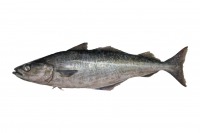
(Photo: Claude Nozères)
Pollock
Pollachius virens
Brownish green with a slightly paler underside. Three dorsal fins. Smooth lateral line. Small barbel at the tip of its jaw in young fish but this may be minute or absent in older fish. Average weight of 2.2 to 4.5 kilograms and length of 30 to 110 centimetres. But can reach over 6.8 kilograms and 130 centimetres in length.
Authority
Linnaeus, 1758
Classification Details
Phylum: Chordata (chordates); Subphylum: Vertebrata (vertebrates); Class: Actinopterygii (ray-finned fishes).
Habitat
Unlike other cod-like fishes this species spends little time on the seabed. Adults are usually found in the water column where they form shoals composed of fish of similar size. Young fish (up to two years old) are mainly found in shallow waters inshore, including rocky subtidal and intertidal zones. Older fish move into deeper water and out to offshore banks. Found on both sides of the North Atlantic. In the western North Atlantic found from Greenland down to Cape Hatteras.
Diet
Predator. Larval pollock eat mainly copepods. Young fish eat crustaceans, particularly amphipods. Older fish eat krill, crustaceans and fish including herring, sand lance and redfish.
Reproduction
Separate sexes. Adults mature at two to three years. In the Gulf of Maine spawning occurs from November to February. Females produce between 200 000 and eight million eggs. Fertilization is external. Spawning occurs over stony or rocky seabeds. Fertilized eggs float in the seawater until they hatch after five to ten days. The pelagic larval stage lasts for three to four months, after this the small juveniles, also known as harbor pollock, migrate inshore. Adults can live for up to 18 years.
Fun Facts
Like other fish, this species has many common names. In English speaking countries names include coalfish, coley, blackjack, billet, Boston bluefish, dargie, gloshan, glassan, green cod, pollock, poodler, rock halibut, saithe and sillock. Using Latin scientific names, of which there can be only one per species, makes sure scientists are talking about the same thing.
The common name, coalfish, comes from the fact that its flesh is dark coloured. This gave it an undeserved reputation that it was poor eating.
References
Cargnelli LM, Griesbach SJ, Packer DB, Berrien PL, Johnson DL and Morse WW (1999) Pollock Pollachius viriens, life history and habitat characteristics. NOAA technical memorandum NMFS-NE-131, 38p. Cohen DM, Inada T, Iwamoto T and Scialabba N (1990) Gadiform fishes of the world (Order Gadiformes): An annotated and illustrated catalogue of cods, hakes, grenadiers and other gadiform fishes known to date. FAO Species Catalogue Volume 10. FAO, Rome. 452 pp. Froese R and Pauly D (2019) FishBase. Pollachius virens (Linnaeus, 1758) Saithe https://www.fishbase.se/summary/Pollachius-virens.html Accessed online 22 January 2020. Scott WB and Scott MG (1988) Atlantic fishes of Canada. Canadian Bulletin of Fisheries and Aquatic Sciences 219, 731p.

